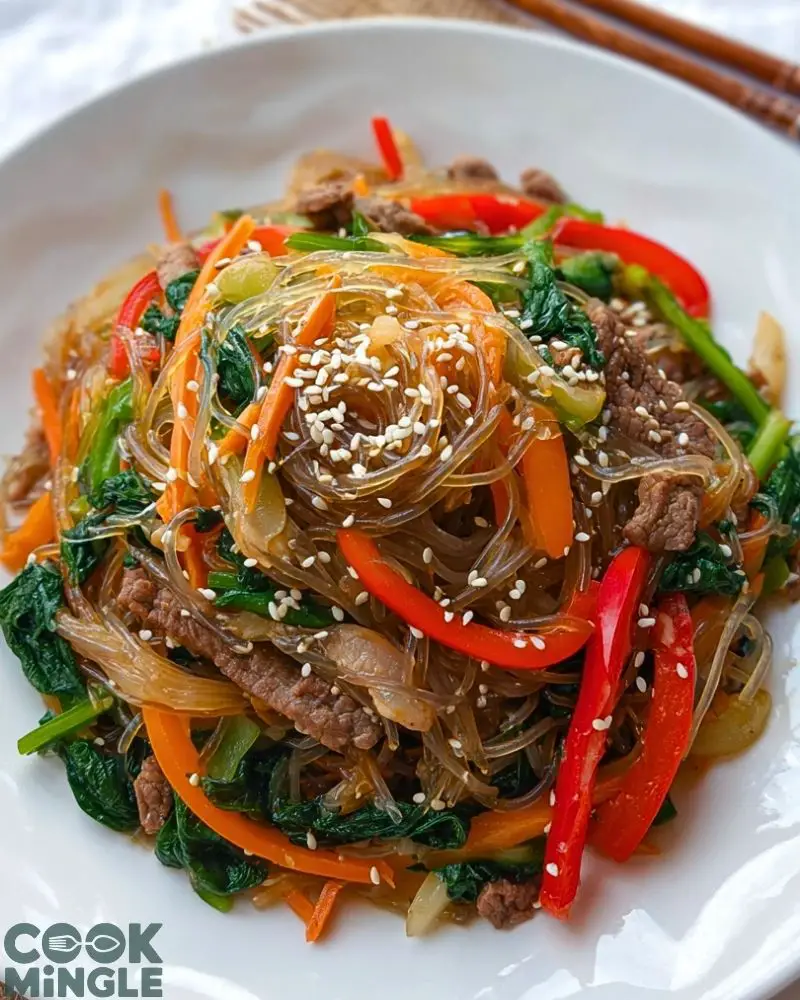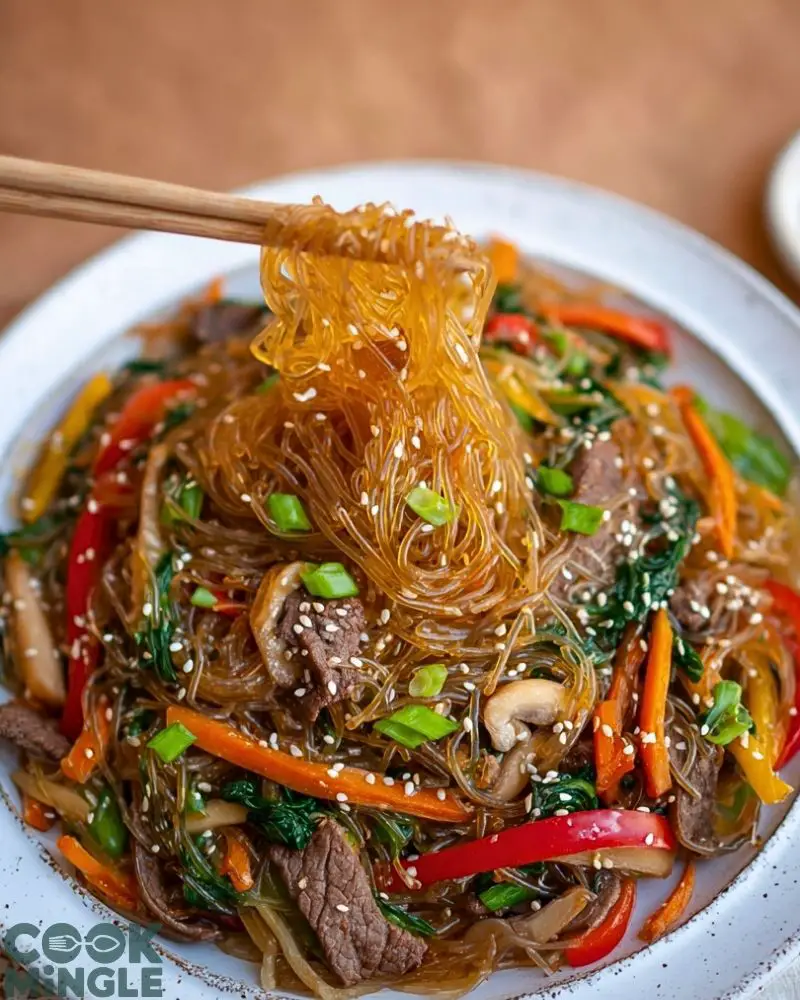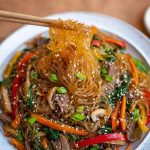I still remember the first time I tasted Japchae—it was at a friend’s Korean dinner party, and one bite of those sweet-savory noodles tangled with crisp vegetables and tender beef had me hooked. Naturally, I had to learn how to make it myself. After a few attempts and tweaks, I finally mastered an easy version that’s both satisfying and quick to throw together on a busy weeknight.

Japchae is one of those dishes that tastes like you spent all day on it, but with a little planning, it’s surprisingly simple. The glass noodles soak up the soy-garlic sauce perfectly, the vegetables retain their bite, and the beef adds a richness that makes it feel hearty enough for a main course. Whether you’re new to Korean food or already a fan, this Easy Japchae might just become one of your go-to favorites.
Why You’ll Love This Easy Japchae
Easy Japchae is a beautiful balance of flavor, texture, and color. It’s naturally gluten-free thanks to the sweet potato noodles, and it packs in a variety of vegetables, making it both nourishing and satisfying. You can serve it hot or cold, which makes it versatile enough for dinner, potlucks, or lunchboxes. Plus, the sweet and savory sauce is so addictive, even picky eaters find themselves going back for seconds.
What Kind of Noodles Should I Use for Japchae?
For Japchae, the noodles are really the star—specifically dangmyeon, which are Korean sweet potato starch noodles. They have this springy, chewy texture that holds up beautifully to stir-frying and soaks in every drop of that rich soy-garlic-sesame sauce. You can usually find them at Asian grocery stores or online. If you’re in a pinch, other glass noodles like mung bean noodles can work, but the texture and taste won’t be quite the same.
Options for Substitutions
If you need to tailor Japchae to suit different diets or what you have on hand, there are plenty of ways to go about it:
- Protein: Swap beef for chicken, shrimp, tofu, or go meatless entirely.
- Gluten-Free Soy Sauce: Use tamari or coconut aminos if you’re avoiding gluten.
- Vegetables: Bell peppers, spinach, carrots, and onions are common, but mushrooms, zucchini, or even kale work great too.
- Vegan Version: Skip the meat and egg, and add extra mushrooms or tofu for umami richness.
- Low-Sodium: Opt for a low-sodium soy sauce and reduce the overall sauce quantity slightly.
These swaps won’t compromise the dish—they just open it up to more flexibility depending on your pantry or dietary needs.
Ingredients for This Easy Japchae
- Sweet Potato Noodles (Dangmyeon): These translucent, chewy noodles are the base of Japchae. They absorb the flavors of the sauce while maintaining their unique texture.
- Beef (Ribeye or Sirloin): Thinly sliced beef adds richness and protein. Marinating it briefly infuses it with extra flavor.
- Soy Sauce: The salty backbone of the dish. It seasons everything from the beef to the vegetables and noodles.
- Sesame Oil: Toasted sesame oil gives Japchae its signature nutty aroma and finish.
- Garlic: Fresh minced garlic adds punch and depth to the sauce and stir-fry.
- Sugar: Just a touch balances out the soy sauce and brings a sweet-savory harmony.
- Carrots: Julienned carrots add sweetness, color, and crunch.
- Red Bell Pepper: Adds a pop of color and a juicy, sweet flavor.
- Spinach: Quickly blanched, it brings earthiness and a pop of green to the mix.
- Onion: Sliced onion caramelizes slightly when sautéed, adding sweetness and body to the dish.
- Green Onion: Adds sharpness and freshness to brighten everything up.
- Sesame Seeds: Sprinkled on top, they add crunch and visual appeal.
Each ingredient plays a key role in balancing flavor, texture, and color, creating the layered harmony Japchae is known for.

Step 1: Prep the Ingredients
Start by soaking the sweet potato noodles in warm water for about 30 minutes, or boil them for 6–7 minutes if you’re short on time. While they soften, thinly slice the beef, julienne the vegetables, and mince the garlic. Blanch the spinach quickly in boiling water, then rinse under cold water and squeeze out excess moisture.
Step 2: Marinate the Beef
Combine the sliced beef with a bit of soy sauce, sesame oil, minced garlic, and sugar. Let it sit while you prepare the rest—about 10 to 15 minutes is enough to soak in the flavors.
Step 3: Cook the Noodles
Boil the softened noodles for about 6–7 minutes (if not already cooked), then rinse under cold water and drain well. Toss with a little sesame oil to prevent sticking.
Step 4: Sauté the Vegetables
Heat a bit of oil in a large skillet or wok. Stir-fry the onion, carrots, bell pepper, and green onions one by one (or all together if you’re in a rush), seasoning each with a touch of soy sauce. Set aside each as they finish cooking to avoid overcooking.
Step 5: Cook the Beef
Using the same pan, cook the marinated beef over medium-high heat until browned and cooked through. This should take about 2–3 minutes.
Step 6: Combine Everything
In a large bowl or the same skillet, toss the cooked noodles, sautéed vegetables, beef, and blanched spinach together. Add more soy sauce, sesame oil, garlic, and sugar to taste. Stir-fry everything for 2–3 minutes until well combined and heated through.
Step 7: Garnish and Serve
Sprinkle sesame seeds on top and serve hot, warm, or even at room temperature. Japchae is delicious at every temperature!
How Long to Cook the Easy Japchae
From start to finish, Easy Japchae takes about 35–40 minutes. Here’s a quick breakdown:
- Prep Time: 15–20 minutes (slicing, marinating, and soaking noodles)
- Cooking Time: 15–20 minutes (noodles, vegetables, beef, and combining everything)
It’s a great meal to make ahead or even double for leftovers the next day.
Tips for Perfect Easy Japchae
- Slice Everything Thin: Uniform, thin slices of veggies and beef help them cook quickly and evenly.
- Don’t Overcook the Noodles: They should be soft but still chewy—overcooking leads to a mushy texture.
- Use High Heat for Stir-Frying: This helps keep the vegetables crisp and the beef tender.
- Season in Layers: Lightly seasoning each component (like veggies and beef) builds richer overall flavor.
- Toss With Oil Early: Coat the noodles in a bit of sesame oil right after cooking to prevent them from sticking together.
- Taste and Adjust at the End: The final flavor should be a perfect balance of savory, sweet, and nutty—adjust soy sauce, sugar, and sesame oil as needed.
These little techniques go a long way in turning a good Japchae into a great one.
Watch Out for These Mistakes While Cooking
Even though Japchae is a forgiving dish, a few missteps can throw off the balance. Keep these common pitfalls in mind:
- Overcooking the Noodles: It’s easy to turn sweet potato noodles into a gummy mess. Keep an eye on the timer and rinse them under cold water immediately.
- Skipping the Blanch for Spinach: Raw or overcooked spinach can taste off. A quick blanch keeps it tender and bright green.
- Crowding the Pan: Sauté vegetables in batches if needed—crowding traps steam and makes them soggy.
- Undermixing at the End: Japchae needs a thorough final mix so that the sauce, noodles, and ingredients combine evenly.
- Forgetting to Taste: Always adjust seasoning after combining. A dash more soy sauce or sesame oil can really elevate the dish.
What to Serve With Easy Japchae?
Japchae is a standalone hero, but pairing it with other dishes can create a beautiful Korean-style spread. Here are a few great companions:
Korean Dumplings (Mandu)
Crispy outside, juicy inside—these are a great side for Japchae and can be pan-fried, steamed, or boiled.
Kimchi Pancakes (Kimchijeon)
Savory, crispy, and packed with kimchi goodness—these add contrast and spice to the sweeter flavor of Japchae.
Miso Soup
Though Japanese in origin, a light miso soup with tofu and scallions is a nice, gentle complement.
Napa Cabbage Kimchi
The tangy crunch of fermented kimchi pairs naturally with Japchae’s sweet and nutty profile.
Korean Fried Chicken
Crispy, sticky, and flavorful, it’s a great indulgent partner if you’re making Japchae for a gathering.
Steamed Egg (Gyeran Jjim)
Soft and silky, this Korean custard-style egg dish brings a gentle, soothing texture to the table.
Steamed Rice
Simple but essential—especially if you’ve made a spicier side dish.
Storage Instructions
Japchae stores incredibly well, making it a favorite for meal prep or leftovers. Once cooled, transfer it to an airtight container and refrigerate for up to 4 days. To reheat, you can microwave it or quickly stir-fry it in a pan over medium heat. If the noodles seem dry, add a splash of water and a drizzle of sesame oil before reheating to bring back the shine and softness.
Freezing isn’t recommended, as the texture of the noodles can become mushy and the vegetables lose their crunch after thawing.
Estimated Nutrition
Here’s a rough estimate per serving (based on 4 servings total):
- Calories: 420
- Protein: 16g
- Carbohydrates: 55g
- Fat: 16g
- Saturated Fat: 3g
- Unsaturated Fat: 10g
- Cholesterol: 30mg
- Fiber: 5g
- Sugar: 8g
- Sodium: 750mg
These numbers will vary depending on portion size and any substitutions (like using tofu instead of beef or adjusting sauces). Japchae is naturally nutrient-dense thanks to its rainbow of vegetables and balanced macros.
Frequently Asked Questions
What does Japchae mean?
“Japchae” (잡채) translates to “mixed vegetables,” but the dish has evolved to include glass noodles and often beef or other proteins. It’s a staple in Korean cuisine, especially during holidays and celebrations.
Can I make Japchae vegetarian or vegan?
Absolutely! Just skip the beef and egg (if using) and substitute with tofu, mushrooms, or extra veggies. The flavor still shines through with the sauce and stir-fried vegetables.
Do I have to use sweet potato noodles?
For authentic taste and texture, yes. But in a pinch, you can substitute with glass noodles made from mung bean or even soba noodles—just note the final dish won’t be quite the same.
Is Japchae served hot or cold?
It can be served hot, warm, or cold, making it incredibly versatile. Many people enjoy it cold or at room temperature, especially in lunchboxes or at picnics.
Can I make Japchae ahead of time?
Yes! In fact, Japchae often tastes even better the next day as the flavors meld. Just refrigerate and reheat gently when ready to serve.
How do I keep the noodles from sticking together?
Toss the cooked noodles with a little sesame oil immediately after draining. This keeps them separated and flavorful.
What kind of beef is best for Japchae?
Ribeye, sirloin, or any tender cut works well. Make sure to slice it thinly against the grain for the best texture.
Is Japchae spicy?
Traditional Japchae is not spicy at all. But you can add a bit of gochugaru (Korean chili flakes) or gochujang if you’d like a little heat.
Conclusion
Easy Japchae is one of those dishes that feels like comfort food from the very first bite. It’s vibrant, satisfying, and endlessly adaptable, whether you’re cooking for guests or meal-prepping for the week. Once you get a feel for the flow—soaking noodles, stir-frying ingredients, and bringing it all together—it becomes a fun, rewarding recipe that never gets old. If you haven’t made it yet, this might be your sign to start.

Easy Japchae
- Total Time: 40 minutes
- Yield: 4 servings
Description
Japchae is a beloved Korean dish made with chewy sweet potato noodles, stir-fried vegetables, and tender marinated beef, all tossed in a deliciously savory-sweet sesame soy sauce. This easy version brings all the authentic flavors with a simpler, more accessible method. Perfect for weeknight dinners, potlucks, or make-ahead lunches, this colorful and flavorful dish is a guaranteed crowd-pleaser.
Ingredients
6 oz sweet potato noodles (dangmyeon)
6 oz beef (ribeye or sirloin), thinly sliced
2 tbsp soy sauce (plus more to taste)
2 tsp sesame oil (plus more for noodles)
2 cloves garlic, minced
1 tbsp sugar
1 small carrot, julienned
1/2 red bell pepper, thinly sliced
2 cups spinach
1/2 onion, thinly sliced
2 green onions, sliced
1 tbsp sesame seeds
1 tbsp neutral oil (for stir-frying)
Instructions
1. Soak sweet potato noodles in warm water for 30 minutes, or boil for 6–7 minutes until soft. Drain and rinse with cold water. Toss with a little sesame oil to prevent sticking.
2. In a bowl, mix beef with 1 tbsp soy sauce, 1 tsp sesame oil, 1 clove minced garlic, and 1/2 tbsp sugar. Let marinate for 10–15 minutes.
3. Blanch spinach in boiling water for 30 seconds. Rinse under cold water and squeeze dry.
4. Heat 1/2 tbsp oil in a skillet and stir-fry onion, carrot, bell pepper, and green onions one at a time, seasoning lightly with soy sauce. Set aside.
5. In the same skillet, cook marinated beef until browned and cooked through, about 2–3 minutes. Set aside.
6. In a large bowl or skillet, combine noodles, vegetables, spinach, and beef. Add remaining soy sauce, sesame oil, garlic, and sugar. Toss or stir-fry everything for 2–3 minutes until well mixed and heated.
7. Sprinkle with sesame seeds and serve hot, warm, or at room temperature.
Notes
Enjoy hot or cold. You can customize it with tofu or more vegetables for a meat-free version.
- Prep Time: 20 minutes
- Cook Time: 20 minutes
- Category: Main Course
- Method: Stir-fry
- Cuisine: Korean
Nutrition
- Serving Size: 1 serving
- Calories: 420
- Sugar: 8g
- Sodium: 750mg
- Fat: 16g
- Saturated Fat: 3g
- Unsaturated Fat: 10g
- Trans Fat: 0g
- Carbohydrates: 55g
- Fiber: 5g
- Protein: 16g
- Cholesterol: 30mg

